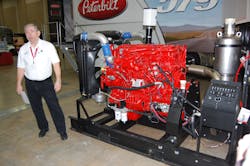Cummins takes 12L natural gas engine on the road
As it readies the 12L ISX-G to begin production in mid-2013, Cummins is taking this natural gas-fired heavy truck engine unit on the road to fleets and dealerships to explain the engineering “subtleties” that make it different not only from its diesel-powered counterparts but from the OEM’s other natural gas engine models as well, especially the 8.9L ISL-G.
At the 2012 Rush Technician Skills Rodeo held this week in San Antonio, TX – an annual contest put together by Rush Truck Centers (RTC), a division of Rush Enterprises – Cummins displayed a “test sled” featuring a pre-production 12L ISX-G powered by compressed natural gas (CNG).
Such “sleds” display pack a fully-functional engine, radiator, emission control system and fuel supply into a single compact test unit that can be taken to fleet shops and dealerships for technicians to study.
Fred Murphy, Cummins’ service training manager, provided an extensive overview of the 12L ISX-G – which will be built at Cummins’ plant in Jamestown, NY – to the RTC technicians competing at the Rodeo; focusing on several key components that are critical to the proper operation of a natural gas-only engine.
One regards the high pressure regulator, where the CNG fuel stored at a pressure of 3,600 pounds per square inch (PSI) is lowered to 100 PSI; a process that creates a “cooling effect” that must be counteracted.
“When you take a gas high to low pressures like that, it can freeze the regulator; that’s why it needs to be kept warm,” Murphy explained.
[You can watch a video detailing that and other critical parts on the 12L ISX-G by clicking here.]
He stressed that no injection of natural gas takes place in either the ISX-G or ISL-G natural gas engines. [Editor’s note: that word is used incorrectly in the video above.] Rather, the gas “flows” into the engine, after being mixed with both external air and exhaust recirculated from the combustion chamber.
Murphy also pointed out that the ISL-G “flows” natural gas at 50 to 60 psi, whereas the ISX-G flows it at 85 to 101 psi. “That pressure variance is due simply because the pressure created by the turbocharger on the ISX-G is higher,” he said. “Thus we have to ‘match’ that higher pressure with the flow rate for the natural gas.”
The double fuel filters attached to the natural gas fuel prior to it being “flowed” into the engine helps clean the vapor of any contaminants – mainly oil picked up when it is compressed at a filling station – so those contaminants do not coat all-important sensors measuring the flow rate of the gas.
The 12L ISX-G, by the way, is being targeted for North American regional haul and vocational operations – for trucks and tractors alike working in intermodal, distribution, pickup and delivery applications – along with the refuse market.
Cummins has noted previously that the 12L ISX-G will operate exclusively on natural gas (either CNG or liquid natural gas, called “LNG”) using proprietary spark-ignited “stoichiometric” combustion with cooled exhaust gas recirculation (EGR) technology developed by its partner Westport Innovations – technology first introduced with the 8.9L ISL-G.
Murphy noted that neither the ISX-G nor the ISL-G "cares" whether its fueled by CNG or LNG, because the LNG is turned back int oa vapor before it's flowed into the engine; thus it behaves just like CNG.
Preliminary specifications include a range of ratings to 400 hp. and 1,450 lbs.-ft. of torque, optional engine brake, with the ability to connect with either a manual or automatic transmission.
Cummins is also working on a 15L version of the ISX-G, which is being readied for production after work on the 12L ISX-G wraps up. [Click here for a video providing more information on that development.]
The 12L ISX-G engine also features a three-way exhaust aftertreatment catalyst that functions very differently from what’s used on 2010-compliant diesel engines, Murphy stressed.
For starters, no diesel particulate filter (DPF) or selective catalytic reduction (SCR) aftertreatment will be required – and that’s why the oxygen sensor attached to the exhaust stream plays a very critical role in terms of gauging proper engine operation, he said.
“If there’s too much oxygen or O2 coming out of the combustion process, then we’ve got a ‘lean mixture’ which could lead to a ‘lean misfire’ in the cylinder,” Murphy added.
A “lean misfire” simply means not enough natural gas is present for proper combustion and thus engine power may suffer as a result, he explained. However, if too little oxygen is flowing in the exhaust, that means too much methane is coming out of the tailpipe, said Murphy – and over time excessive methane could damage or “poison” the three-way catalyst.
In fact, a special sensor measuring the humidity in the air is also part of the ISX-G’s electronics package, because changes in humidity will alter how much external air needs to be allowed into a natural gas engine in order to keep both the air and gas properly mixed for ideal combustion.
“These are just some of differences technicians will encounter with these engines,” Murphy noted.
About the Author
Sean Kilcarr
Editor in Chief
Sean Kilcarr is a former longtime FleetOwner senior editor who wrote for the publication from 2000 to 2018. He served as editor-in-chief from 2017 to 2018.
